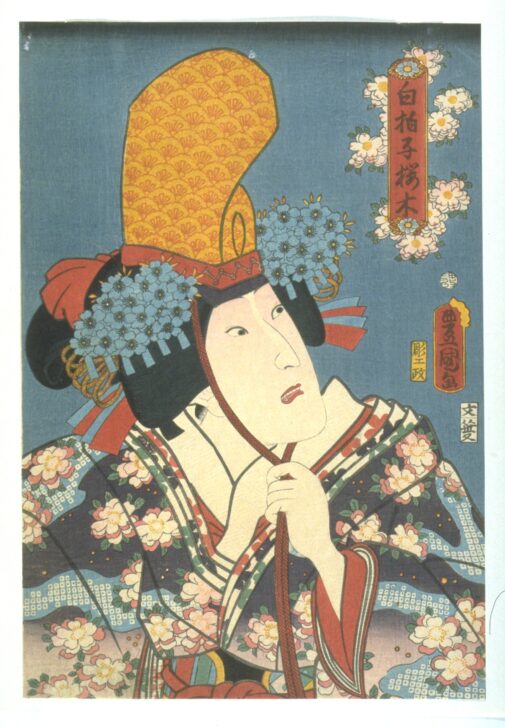Dōjō Temple (Dōjōji): Onoe Kikugorō IV as Shirabyōshi Dancer Sakuragi
Utagawa Kunisada

Description
Shirabyôshi were itinerant female dancers of medieval Japan, who traveled the country in male dress. Here we see a kabuki actor in a role as the shirabyôshi Sakuragi, whose name means "cherry tree," a point the artist drives home with cherry blossoms in the kimono and in the background. Thus we have a double layer of cross-dressing here, with a male actor in the guise of a woman dancer garbed in men’s clothing.
Utagawa Kunisada was a pupil of Utagawa Toyokuni, from whom he took the Utagawa name. In 1844 he began to sign his prints "Toyokuni" and refer to himself as Toyokuni II, despite the fact that another pupil had already claimed that title. Kunisada did many privately commissioned actor prints in which printing technology was pushed to new levels of refinement, and some of the new developments are seen here. This print is in excellent condition, still retaining a strong impression of gauffrage or blind printing. The brilliant colors are the result of the use of imported chemical-based aniline dyes.
M. Graybill
"Courtesans, Cross-Dressers, and the Girl Next Door Images of the Feminine in Japanese Popular Prints"
3/9 - 9/1/02
Subject Matter:
Shirabyōshi were itinerant female entertainers, known for their dances to popular songs and rhythmic accompaniment. The practice developed from the late twelfth century where shirabyōshi were associated with religious performance. These generally lower class women were famous for dressing in men’s, specifically warriors’ clothing including a white top, sword, and tall hat (eboshi).
Onoe Kikugorō IV was active from 1831 until 1860, just prior to his death. He was a member of the Onoe line of kabuki actors. The Onoe line is one of the oldest lines of actors, with more than 250 years of history. In this print, Kikugorō plays the main character of the play, a shirabyōshi named Sakuragi (lit. “cherry tree”). Her name is emphasized in the print by the cherry blossoms on her robe and on the inscriptions. The play, Dōjō Temple, famous in both kabuki and nō theater, recounts an incident during the bell raising at Dōjō Temple. A shirabyōshi gains access to the temple grounds by performing a dance for the guards. She is revealed to be a monstrous serpent who had destroyed the previous bell. There are numerous variants of this play, known as Dōjōjimono, that tell different parts of the story focused on the destruction of the Dōjō Temple bell.
Utagawa Kunisada was a pupil of Utagawa Toyokuni, from whom he took the Utagawa name. In 1844 he began to sign his prints "Toyokuni" and refer to himself as Toyokuni II, despite the fact that another pupil had already claimed that title. Kunisada did many privately commissioned actor prints in which printing technology was pushed to new levels of refinement.
Physical Description:
A woman looks anxiously to her left while clutching the strings of her tall, orange hat (eboshi). She wears a multi-layered robe; the colorful cherry-blossom pattern on the dark outer robe is repeated in monochrome colors in the layers beneath. Cherry blossoms frame the inscriptions on a solid blue background.
Inscriptions: Bun, Sasamata (Publisher's seal); saru 3 aratame (Censor's seal); Shirabyōshi Sakuragi; Toyokuni ga (Signature)
Usage Rights:
If you are interested in using an image for a publication, please visit https://umma.umich.edu/request-image/ for more information and to fill out the online Image Rights and Reproductions Request Form.